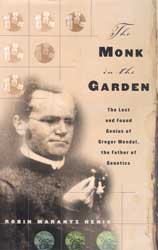By Robin Marantz Henig
Hardcover: 292 p. Boston: Houghton Mifflin, 2000. $24.00.
Paperback: Boston: Mariner Books (Houghton Mifflin), 2001. $14.00.
Reviewed by Ian E. M. Donovan, Pembroke, Massachusetts
Robin Marantz Henig makes science exciting as she sorts out myth from the facts as we know them in her retelling of the story of Gregor Mendel. It is a far cry from the simple tale we learned in high school or from college biology texts. The two settings for Marantz's retelling are Moravia and its revolutionary turmoil in the mid Nineteenth Century Austro-Hungarian Empire; second is the subsequent European rediscovery of Mendel's work on the edge of the Twentieth Century. Marantz tells us both stories.

Who emerges from this well researched study is a quiet, scholarly man, often wrestling with his own internal dragons that restrained him at each essential career step. Mendel failed at the family farm, at parish work, and at qualifying for higher teaching certification; he often took to bed for weeks at a time with a mysterious illness. He was rescued by a mentor who guided him into the St. Thomas monastery in Brunn, then the capital of Moravia. The monastery was run by free-thinking Augustinian monks of the Monravian Catholic Church, and it was the Abbot there who gave Mendel his opportunity at science. The Augustinian Order was a group of scholarly monks who wanted to pursue their bliss in the natural sciences, music, and physics, without interference from the Catholic Church or the state. And they did.
This monastery became Mendel's adult home and the location of his beloved glasshouse and garden. He eventually succeeded to the position and title of the monastery's Abbot, which he retained until his death in January 1884.
But what of his seven-year, carefully constructed experiments in breeding local Pisum sativum--pea--plants? This came about because the governing Bishop, during an inspection visit to the monastery, vetoed Mendel's breeding experiments in his quarters, using mice--mammals. Breeding was sex. Not appropriate in the Bishop's eyes--but plants were benign. No sex there!
Mendel delivered two lectures reporting his solitary experimental work to the Brunn Society in 1865. These were published the next year in their obscure journal. Mendel sent forty reprints to important European scientists, which were ignored. Charles Darwin, whose theoretical Origin of the Species was published in 1859, never even cut the pages on his copy of Mendel's paper. At his passing, all Mendel's papers and notebooks were burned!. So much for the work of the founder of genetic science.